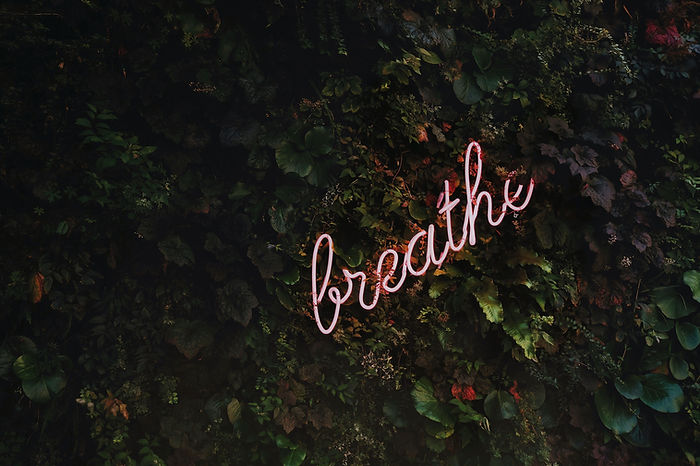
Creator and founder of breath~breaks. Discovered breath breaks after 7+ years of trying to integrate mindful practices into daily life.
In our fast-paced world, stress has become an all-too-familiar companion. Nearly half of U.S. adults (around 45%) report that they frequently feel stressed (time.com) – a reminder that many of us, especially busy professionals and students, are operating on autopilot and feeling overwhelmed.

If you’ve ever felt disconnected from the present moment or weighed down by constant pressure, you’re not alone. But here’s the good news: the solution might be simpler (and quicker) than you think. Enter the “breath break” – a brief, mindful breathing practice designed to help you reset, refocus, and take intentional action in the middle of your busy day.
As you’ll see, taking a moment to breathe might be the most effortless way to bring mindfulness into your everyday life, boosting your mood, focus, and overall well-being.
What is a breath break?
A breath break is a short mindfulness practice anchored in breath. The exact sequence can vary but most likely it looks something like this:
- Become present here and now,
- Calm down through mindful breathing,
- Check in with how you are feeling,
- Connect to what matters,
- Continue with intentional action.
Taking a moment to close your eyes and breathe deeply can serve as a powerful reset during a hectic day. Consider it a quick timeout to get air into your body and then back out, letting go of tension with each exhale. Even a few seconds of conscious breathing is often enough to pull you out of “fight or flight” mode and into a state of greater calm and presence.
Beneath its simplicity lies real impact. Simply observing your breath can dampen stress and open the door to a healthier, more mindful state of being. Think of a breath break as an “entry-level” mindfulness technique – it’s easy enough for anyone to try, yet powerful enough to make a difference in how you feel.
No special equipment or experience is required; if you can breathe, you can take a breath break!
Why you need a breath break: Benefits for mind & body
It’s astonishing how much positive change a few intentional breaths can spark. When you’re stressed or anxious, your body’s fight-or-flight response kicks in – your heart races, your muscles tense, and in essence, you even forget to breathe properly (time.com).
A breath break helps reverse this stress response. By slowing down and breathing deeply, you stimulate your vagus nerve (part of the parasympathetic “rest and digest” system), which signals your body that it’s safe to relax. In fact, as one mindfulness teacher explains,

“Slowing your breath can lower your heart rate, release tension and calm your nervous system, relieving symptoms of stress and anxiety” (success.com)
In just a few deep breaths, you begin to shift from anxious and tense to grounded and calm.
And it’s not just about stress relief – you’ll likely notice cognitive benefits too. Deep breathing increases the flow of oxygen to your brain, which helps sharpen your focus and clear mental fog (success.com). Emotionally, conscious breathing creates a short “pause” that lets you step back from panic or anger and regain control. Researchers have found that our emotions are closely tied to our breathing patterns; by deliberately adopting slower, steadier breaths, we can influence our emotional state and feel more at ease. A quick break can even serve as a productivity boost. Brief pauses during work or study have been shown to help maintain energy and performance (hbr.org) – so taking 1–2 minutes to breathe might actually help you return to your tasks with more clarity, not less.
Key breath break benefits include:
- Quick stress relief: Deep, mindful breathing triggers your body’s relaxation response. It can lower elevated heart rate and blood pressure, releasing physical tension and reducing stress hormones (success.com). You’ll feel a wave of calm wash over you within moments.
- Sharper focus and clarity: A short breath break floods your body with fresh oxygen, including your brain. This helps you “sharpen your focus and think a little clearer” (success.com), pulling you out of mental fog or distractions and into a state of clear concentration.
- Emotional balance: Because breathing is linked to emotion, using a breath break to slow your breath can shift you out of states of anxiety or anger. By consciously calming your breath, you send a signal to your nervous system that eases intense emotions and helps you feel more stable (time.com).
- Mindfulness and presence: Incorporating breath breaks trains you to reconnect with the present moment. These mini-pauses break the cycle of running on autopilot. Each breath break is a reminder to be here now, helping you feel more grounded and connected rather than scattered.
- Energy reset: When you’re exhausted or hitting that afternoon slump, a breathing break is a quick recharger. Stepping away from work for a couple of minutes to breathe can refresh your mind and prevent burnout, so you return to your tasks feeling re-energized (hbr.org).
For all these reasons, a breath break can be a powerful addition to your self-care toolbox.
“Breath is the simplest and most effective tool that allows us to respond rather than react and override negative feelings and beliefs” (time.com)
By taking regular breath breaks, you empower yourself to meet daily challenges with a calmer mind, a steadier heart, and a bit more optimism.

How to Take a Breath Break (Technique)
One of the best things about breath breaks is how simple they are. You don’t need a yoga mat, a meditation cushion, or even a quiet room (though a peaceful spot can help).
Here’s a short breath break sequence you can try right now:
- Pause and get comfortable. Stop what you’re doing and sit (or stand) in a relaxed position. If possible, step away from distractions. You can close your eyes if you’re comfortable, or simply soften your gaze.
- Inhale deeply through your nose for a slow count of 4. Feel your belly and chest gently expand as you fill your lungs with air.
- Hold your breath for 1-2 seconds at the top of your inhale. (No need to hold for long – just a brief pause.)
- Exhale slowly through your mouth for a count of 6, letting the air escape naturally. As you breathe out, try to relax your shoulders and release any tension. Imagine the stress leaving your body with each exhale.
- Repeat this breathing cycle for about 3-5 rounds, or roughly 30-60 seconds. Maintain a slow, comfortable rhythm. If your mind starts to wander, gently bring your attention back to the feeling of your breath moving in and out.
That’s it! You’ve just taken a breath break!
Feel free to adjust the counts to what feels comfortable (for example, some people like a 4-4-4-4 box breathing pattern, or the classic 4-7-8 technique). There’s no single “right” way – the key is simply to breathe slowly, deeply, and mindfully. To be in the Here ~ Now.
How long should a breath break be? It can be as short as half a minute or as long as a few minutes – whatever fits your situation. Even one deep, mindful breath can help allow your body and mind to fully shift into a calmer state.
So try using breath breaks whenever you notice stress building up or when you catch yourself going on autopilot. Over time, you might start taking these mini relaxation pauses naturally. The more you practice, the more easily you will be aware of your mind and body state. With time, "Oh, I feel stressed and should take a short break", will be a much more common realisation.
Making breath breaks a daily habit
Like any healthy action, consistency is key. The real benefits of breath breaks unfold when you integrate them into your daily life. The good news is, this doesn’t require much time or effort – just a little intentionality. Here are some tips to make breath breaks a seamless part of your day:
- Pair with routines: Add a 1-minute breath break to daily habits like waking up, sipping coffee, or starting work. Linking it to existing tasks helps build consistency.
- Use transitions: Pause and breathe between tasks, before meetings, or when energy dips. These in-between moments are perfect for a reset.
- Respond to stress: Feeling tense? Use that as your signal to take a breath break. A few deep breaths can help you calm down and refocus.
- Anywhere, anytime: Breath breaks are discreet and free. Whether you’re at your desk, in line, or commuting, you can always take a mindful moment to breathe.
Most importantly, as you start this practice - be kind to yourself. Some days you might forget to take a break, or you’ll get caught up in the whirlwind of work and studies. That’s okay! Whenever you do remember, just take that first conscious breath. Each breath break is a small act of self-care that can make your day a little better. Consistency will come with time, and you’ll soon wonder how you managed without these little mindful moments.
How breath~breaks™ can help
This is exactly where breath~breaks™ comes in. We’ve reimagined mindful breathing as something that’s not just easy, but beautiful, affordable and delightfully simple.
Our accessory gently vibrates throughout the day, inviting you to pause for a few mindful breaths. No screens. No data. No apps. Just a tactile reminder to return to yourself, again and again. Providing you with more than 20 breath breaks per day, it takes your practice from a good intention into an effortless daily habit.
Questions & Answers (Q&A)
Q: How do you take a breath break?
A: A breath breaks is customisable to your situation and need. It's actually more about your presence and intention than the exact sequence. We encourage you to create your own breath break. The simplest version takes no more than 5 seconds:
- Becoming present here and now.
- Take one deep, mindful inhale.
- Connect to what matters.
- Continue with intentional action.
Q: How long should a breath break be?
A: Anywhere from 5 seconds to a several minutes. Even one deep breath will help you feel in charge, but sometimes you might need a little more - maybe a meditation or a walk in the sun? You should customise your break based on situation and need. By taking many small breaks during the day rather than one big session, you stay living in flow state.
Q: Is a breath break hard to do?
A: Not at all. It’s one of the simplest ways to relax. If you can breathe, you can do a breath break—no training needed. Just slow down, tune in and continue with focus.
Q: Why take a breath break?
A: It calms your nervous system, clears your mind, and helps you feel more in control. These small breaks can reduce stress and boost your focus and mood. Fast.
Q: How often should I take a breath break?
A: As often as you can - it's completely natural and takes no effort! We recommend consistency and effortlessness over intensity. It is meant to be a soft check-in that helps you live more mindfully, one breath at a time. Our breath~breaks are programmed to remind you every 30 minutes.
.png)

%402x%20(2).svg)






